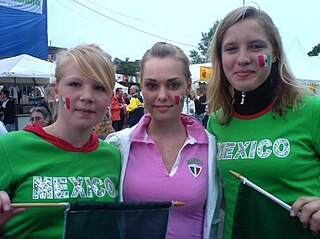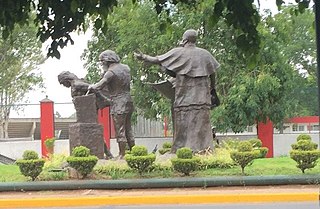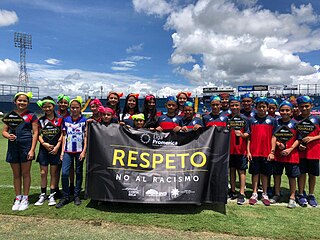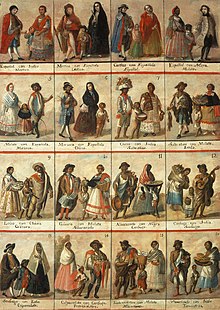
With a population of about 129 million in 2022, Mexico is the 10th most populated country in the world. It is the largest Spanish-speaking country in the world and the third-most populous country in the Americas after the United States and Brazil. Throughout most of the 20th century Mexico's population was characterized by rapid growth. Although this tendency has been reversed and average annual population growth over the last five years was less than 1%, the demographic transition is still in progress; Mexico still has a large youth cohort. The most populous city in the country is the capital, Mexico City, with a population of 8.9 million (2016), and its metropolitan area is also the most populated with 20.1 million (2010). Approximately 50% of the population lives in one of the 55 large metropolitan areas in the country. In total, about 78.84% of the population of the country lives in urban areas, and only about 21.16% in rural ones.

Mestizo is a person of mixed European and indigenous non-European ancestry in the former Spanish Empire. In certain regions such as Latin America, it may also refer to people who are culturally European even though their ancestors are indigenous. The term was used as an ethno-racial exonym for mixed-race castas that evolved during the Spanish Empire. It was a formal label for individuals in official documents, such as censuses, parish registers, Inquisition trials, and others. Priests and royal officials might have classified persons as mestizos, but individuals also used the term in self-identification.

Cholo is a loosely defined Spanish term that has had various meanings. Its origin is a somewhat derogatory term for people of mixed-blood heritage in the Spanish Empire in Latin America and its successor states as part of castas, the informal ranking of society by heritage. Cholo no longer necessarily refers only to ethnic heritage, and is not always meant negatively. Cholo can signify anything from its original sense as a person with one indigenous parent and one Mestizo parent, "gangster" in Mexico, an insult in some South American countries, or a "person who dresses in the manner of a certain subculture" in the United States as part of the cholo subculture.

Mexicans are the citizens and nationals of the United Mexican States.

Casta is a term which means "lineage" in Spanish and Portuguese and has historically been used as a racial and social identifier. In the context of the Spanish Empire in the Americas, the term also refers to a now-discredited 20th-century theoretical framework which postulated that colonial society operated under a hierarchical race-based "caste system". From the outset, colonial Spanish America resulted in widespread intermarriage: unions of Spaniards, indigenous people, and Africans. Basic mixed-race categories that appeared in official colonial documentation were mestizo, generally offspring of a Spaniard and an Indigenous person; and mulatto, offspring of a Spaniard and an African. A plethora of terms were used for people with mixed Spanish, Indigenous, and African ancestry in 18th-century casta paintings, but they are not known to have been widely used officially or unofficially in the Spanish Empire.

Indigenous peoples of Mexico, Native Mexicans or Mexican Native Americans, are those who are part of communities that trace their roots back to populations and communities that existed in what is now Mexico before the arrival of Europeans.

In Hispanic America, criollo is a term used originally to describe people of full Spanish descent born in the viceroyalties. In different Latin American countries, the word has come to have different meanings, mostly referring to the local-born majority.
White Latin Americans or European Latin Americans are Latin Americans of European descent.

White Mexicans are individuals in Mexico who identify as white, often due to their physical appearance or their recognition of European ancestry. The Mexican government conducts ethnic censuses that allow individuals to identify as "White," but the specific results of these censuses are not made public. Instead, the government releases data on the percentage of "light-skinned Mexicans" in the country, which was 47% in 2010 and increased to 49% in 2017. The term "Light-skinned Mexican" is preferred by both the government and media to describe individuals in Mexico who possess European physical traits when discussing ethno-racial dynamics. However, "White Mexican" is still used at times.
In Argentina, there are and have been cases of discrimination based on ethnic characteristics or national origin. In turn, racial discrimination tends to be closely related to discriminatory behavior for socio-economic and political reasons.

Spanish Mexicans are citizens or residents of Mexico who identify as Spanish as a result of nationality or recent ancestry. Spanish immigration to Mexico began in the early 1500s and spans to the present day. The vast majority of Mexicans have at least partial Spanish ancestry; the Northern regions of Mexico have a higher prevalence of Spanish heritage. There are three recognized large-scale Spanish immigration waves to the territory which is now Mexico: the first arrived during the colonial period, the second during the Porfiriato and the third after the Spanish Civil War.

There is no single system of races or ethnicities that covers all modern Latin America, and usage of labels may vary substantially.
In Mexico, the term mestizo is used to refer to an identity of those of mixed European and Indigenous Mexican descent. Some believe it can be defined by criteria ranging from ideological and cultural to self-identification, genetic ancestry, or physical appearance. According to these criteria, estimates of the number of mestizos in Mexico vary from about 40 percent of the population to over 90% who do not belong to the country's culturally indigenous minorities. A survey done by Latinobarometro in 2018 found that around 58% of Mexicans self-identify as mestizos when asked about their race, and another survey by Cohesión Social found that over 70% of Mexicans identified as mixed-race. Some genetic studies have claimed that mestizos make up over 93% of Mexico's present-day population, but this is disputed, with many Mexicans, including those of mixed ancestry, identifying more with static racial labels such as "white" or "indigenous" rather than mestizo, and a large number simply identifying as "Mexican," rejecting racialized labels.

Esther Pineda G., often published as Esther Pineda, is a Venezuelan sociologist and feminist writer. She has written sociological studies, essay collections, and poetic anthologies about misogyny in the history of Western philosophy, the connection between machismo and violence against women, and racial discrimination, particularly against Afro-Venezuelans. Pineda holds a PhD in sociology, and her writing frequently uses tools of sociological analysis.
Racism in Chile encompasses any type of racial or ethnic discrimination by a group of inhabitants or organizations of that country against groups from other nations or the same nation. The origins of Chilean racism, and that of other Latin American nations, can be traced back to 16th century colonialism under the rule of the Spanish Empire. In the establishment of imperial rule, Native Americans experienced extermination, slavery and forced miscegenation.

New Order is a 2020 Mexican-French thriller art film. It takes place in a dystopian near future Mexico. It was written, directed, produced and edited by Michel Franco and is a French-Mexican co-production.

The Monumento a los Constructores, also known as the Monumento a los Constructores de la Ciudad, is a partly-destroyed outdoor bronze monument installed along Acueducto Avenue, in the historic center of Morelia, Michoacán, Mexico. The artwork was created by José Luis Padilla Retana and was unveiled in May 1995 in honor of those who built the city.
Racism in Peru comprises negative attitudes and views on race or ethnicity which are related to each other, are held by various people and groups in Peru, and have been reflected in discriminatory laws, practices and actions at various times in the history of Peru against racial or ethnic groups. Peruvian intellectuals, who were mainly white and based in the developed capital city of Lima, historically denied that racism existed in Peru and did not focus on the social issue, often participating in racism themselves. The concentration of wealth amongst elites in Lima through centralismo resulted with a history of systemic racism in Peru, with individuals in Lima basing their discrimination against rural individuals due to race and geographical location.

"Respect. No to racism" is an anti-racist, anti-discrimination, and tolerance-promoting campaign in Costa Rica's sports events, particularly in the football matches of the Liga FPD. The campaign aims to foster the integration of values in sports environments, with a primary focus on respect.
The Global Coalition Against Systemic Racism and for Reparations is an international platform whose purpose is to promote actions that confront and eliminate systemic racism and advocate for reparations through collaboration among public, private, political, social, business, cultural, and productive entities, as well as international organizations.

















